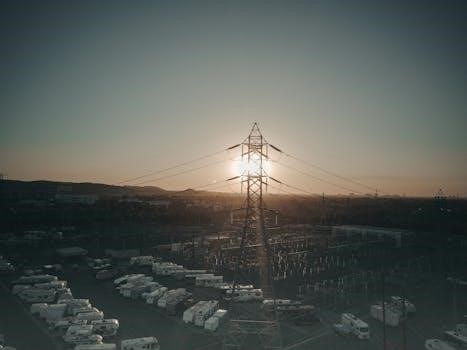Explore comprehensive, high-resolution PDF diagrams detailing off-grid solar power setups. These resources offer schematic representations of complete systems, along with individual component wiring configurations. Simplify your projects with step-by-step guidance, avoiding costly mistakes and ensuring successful installations.
Components of an Off-Grid Solar System
An off-grid solar system comprises several key components working in harmony to generate, store, and distribute electricity independently of the utility grid. Solar panels are fundamental, converting sunlight into direct current (DC) electricity. This DC power is then managed by a charge controller, which regulates the flow of electricity to the battery bank, preventing overcharging and maximizing battery lifespan. The battery bank serves as the energy storage for use during periods of low or no sunlight. An inverter is crucial for converting the stored DC power into usable alternating current (AC) power, which is needed to run most household appliances. Wiring, fuses, and circuit breakers are essential for connecting all the components safely. Other components may include a generator as a backup power source and monitoring equipment to track performance. These elements create a self-sustaining power solution, providing energy independence.
How an Off-Grid Solar System Works
An off-grid solar system operates by harnessing solar energy to power homes and buildings independently from the traditional power grid. The process begins with solar panels capturing sunlight and converting it into DC electricity. This electricity then flows to a charge controller, which regulates the current to prevent overcharging the batteries, ensuring optimal performance and longevity. The batteries store the generated energy, acting as a reserve for times when solar production is low or during nighttime. An inverter then converts the stored DC power from the batteries into AC power, the standard form used by most household appliances. This AC power can then be used to operate lights, televisions, refrigerators, and other electrical devices. The system is designed to be self-sustaining, relying on solar energy to meet daily needs. This approach offers a reliable and renewable energy source for off-grid locations.
Sample Off-Grid Solar Wiring Diagram (PDF)
A sample off-grid solar wiring diagram, typically available in PDF format, provides a visual guide to the connections within a solar power system. It outlines how the various components, such as solar panels, charge controllers, batteries, and inverters, are interconnected. This diagram serves as a practical reference for installers and DIY enthusiasts alike. It clearly illustrates the flow of electricity from the solar panels through the system to the loads, ensuring a safe and efficient setup. The PDF format allows for easy viewing and printing, making it a convenient resource for planning and executing an off-grid solar installation. Often, these diagrams include detailed labels and specifications for each component, providing clear instructions for proper wiring. These sample diagrams are invaluable for understanding the complexities of an off-grid system and minimizing the risk of errors during installation.
Types of Wiring Diagrams Available
Various types of wiring diagrams are available for off-grid solar systems, each catering to different needs and levels of complexity. Basic diagrams might illustrate the core components and their connections, suitable for smaller or simpler systems. Detailed diagrams, on the other hand, provide comprehensive schematics, including specifics on wire gauges, fuse sizes, and component ratings. Some diagrams focus on specific aspects, such as battery bank wiring, inverter connections, or charge controller configurations. You can find diagrams for different system voltages (12V, 24V, 48V), as well as for hybrid systems that integrate solar power with other sources. There are also diagrams designed for particular applications, like RV solar systems or homestead setups. Additionally, some diagrams include step-by-step instructions and troubleshooting tips. Whether you’re looking for a simple overview or a highly detailed technical drawing, a suitable wiring diagram is available to guide your off-grid solar project. These diagrams can be found in PDF format for easy access and printing.
1kW Off-Grid Solar Power Station Wiring Diagram
A 1kW off-grid solar power station wiring diagram illustrates the connections between various components in a small-scale solar system. Typically, this diagram includes solar panels, a charge controller, a battery bank, and an inverter. The solar panels generate DC electricity, which is then regulated by the charge controller to safely charge the batteries. The battery bank stores the energy for later use. The inverter converts the DC power from the batteries into AC power, which is used to run household appliances and electronics. This diagram is essential for properly connecting all components. It provides clear guidance on wire sizes, fuse placements, and grounding points. It is crucial to follow the manufacturer’s instructions for each component in addition to referring to the wiring diagram. A 1kW system is suitable for small cabins, sheds, or as a backup power source. The diagram serves as a visual guide, simplifying the installation process and ensuring a safe and efficient system operation. Remember to always prioritize safety when working with electrical systems.
Detailed Wiring Diagram for Off-Grid Solar System
A detailed wiring diagram for an off-grid solar system provides an in-depth view of how each component is interconnected. This type of diagram goes beyond a basic overview and includes specifics such as wire gauges, fuse ratings, and the precise location of each connection point. It often specifies the types of connectors used, such as MC4 connectors for solar panel connections and ring terminals for battery connections. The diagram will typically show the path of the DC current from the solar panels through the charge controller to the battery bank, and then to the inverter, where it is converted to AC power. It may also include details of any additional components, such as disconnect switches, surge protectors, and grounding equipment. This level of detail is critical for a safe and efficient installation, reducing the risk of wiring errors. It aids in troubleshooting and simplifies maintenance. A high-resolution PDF version of such a diagram is ideal for clear viewing, ensuring every connection is clearly understood. This diagram is an essential resource for anyone undertaking an off-grid solar installation.
Hybrid Off-Grid Solar Power System Diagram
A hybrid off-grid solar power system diagram illustrates how solar power is integrated with other power sources, such as a generator or the utility grid. This diagram showcases the interplay between solar panels, batteries, inverters, and the backup power source, ensuring a reliable power supply. The diagram details how the system automatically switches between solar, battery, and the alternative power source. For example, it shows how the system relies primarily on solar energy when available, switches to battery power during the night or when solar production is low, and engages the generator or grid power as a last resort. The diagram also emphasizes the importance of a hybrid inverter, which manages the flow of energy from different sources, optimizing usage and charging the batteries. A detailed hybrid diagram also illustrates the location of essential components like transfer switches, which facilitate seamless switching between power sources. It is designed for clarity, ensuring that installers and users understand the entire system’s operation and components. The inclusion of labels for each component and clear indications of power flow are standard features.
Emergency Backup Power System Wiring
An emergency backup power system wiring diagram outlines how to set up a system that provides electricity during power outages. This setup often involves batteries, an inverter, and a transfer switch to quickly transition to backup power. The diagram emphasizes the necessity of connecting the batteries to an inverter, which converts the DC power stored in the batteries to usable AC power. It shows the crucial role of the transfer switch, which isolates the electrical circuits from the grid during an outage, preventing back-feeding and ensuring safety. The wiring diagram also specifies the appropriate wire gauges and fuse sizes to handle the required current, preventing overheating or damage to the system. This backup system is designed to power critical appliances such as lights, refrigerators, and communication devices. The layout typically includes a battery charger that can recharge the backup batteries once grid power is restored. Clear markings and labels on the diagram are crucial for correct wiring, minimizing the risk of errors during installation. This diagram is essential for building a reliable emergency power system.
Off-Grid Homestead Solar Wiring Diagram

An off-grid homestead solar wiring diagram illustrates how to establish a self-sufficient power system for a home independent of the electrical grid. This diagram typically includes solar panels, a charge controller, batteries, an inverter, and a distribution panel. The solar panels convert sunlight into DC electricity, which is then managed by the charge controller to prevent overcharging the batteries. The batteries store the electrical energy for later use, and the inverter converts the DC power from the batteries into AC power for household appliances. The distribution panel acts as the central point for distributing power throughout the home, protecting circuits with breakers. Wire sizing is critical in this diagram to handle the loads and prevent energy loss. The diagram also often includes details on grounding for safety, showing connections to earth. This wiring diagram provides a comprehensive view of the system’s layout, ensuring the homestead has a reliable and independent power source; It is essential for building a robust off-grid system, suitable for a homestead environment. It guides users through all critical steps of wiring.
3kW Off-Grid Solar System Wiring Diagram
A 3kW off-grid solar system wiring diagram provides a detailed visual guide on how to connect the components of a small-scale, self-sufficient solar power system. Typically, this diagram will start with the solar panels, which are wired in series or parallel to achieve the correct voltage and current for the charge controller. The charge controller regulates the power going to the battery bank, which stores the energy for later use. From the battery bank, the DC power goes to an inverter, which converts it to AC power suitable for household appliances. The diagram includes all the necessary wiring connections, fuse placements, and safety devices, like circuit breakers, to protect the system from overloads and short circuits. Wire sizes are carefully specified to handle the amperage at different points in the system. This is critical for safety and preventing energy loss, ensuring the system operates efficiently. The diagram will clearly illustrate how to correctly connect all the parts, making the installation process less complex. Additionally, grounding details are shown to prevent electrical hazards. This diagram ensures the user understands the proper way to install a 3kW off-grid system.
5kVA Rooftop Solar PV Plant Wiring Diagram

A 5kVA rooftop solar PV plant wiring diagram illustrates the connections for a system designed to generate a significant amount of power from solar panels installed on a roof. The diagram typically begins with the solar panels array, which are wired together in series and parallel configurations to achieve the necessary voltage and current levels. These panels are then connected to a solar inverter, which is the core of the system, converting the DC electricity from the panels into AC electricity compatible with most household and commercial appliances. The diagram includes information on the correct wire sizes for handling the electricity generated, as well as the placement of essential components like circuit breakers and fuses, which protect the system from overloads and short circuits. The wiring diagram will also detail the connections to the electrical panel of the building, typically through a breaker dedicated to the solar system. Additionally, grounding connections are shown, which are critical for electrical safety. The diagram makes sure that all parts are connected in a safe and proper way. This detailed diagram is essential for installers to accurately set up and maintain a 5kVA rooftop solar plant.

Wiring Diagram for Single-Phase Photovoltaic Installations
A wiring diagram for single-phase photovoltaic installations is crucial for correctly connecting all components of a solar power system designed for single-phase electrical grids. This type of installation is commonly used in residential and small commercial buildings. The diagram begins with the solar panels, which convert sunlight into DC electricity. These panels are wired together, often in series or parallel, to achieve the desired voltage and current. The DC power then flows to a solar charge controller which regulates the voltage sent to the batteries and protects them from overcharging. These batteries store the energy for later use. The next key component is the inverter, which converts the DC power from the batteries into AC power suitable for household appliances. The wiring diagram shows the connections from the inverter to the main electrical panel. It also includes details about circuit breakers, fuses, and grounding, which are all vital for safety and proper system operation. Furthermore, the diagram may show components for grid integration if the system is connected to the utility grid. The wiring diagram is essential for installers to properly connect all the components and ensure the system runs safely and efficiently.

